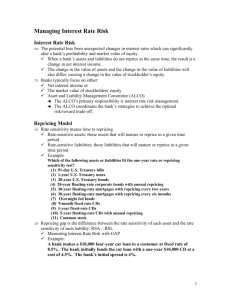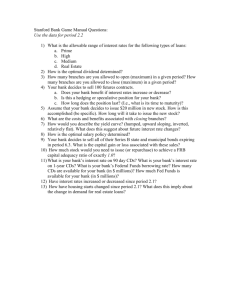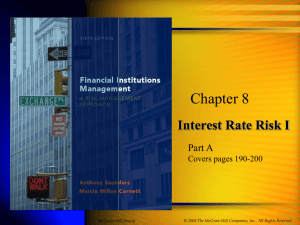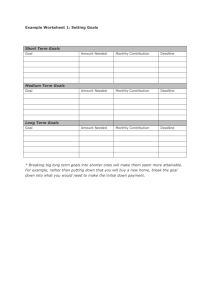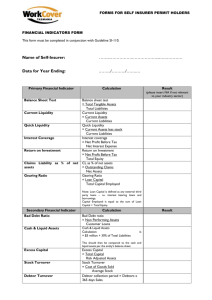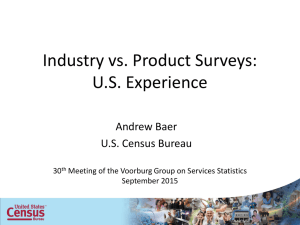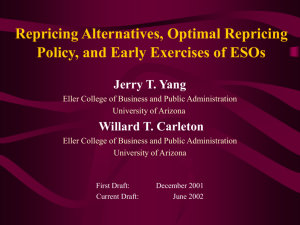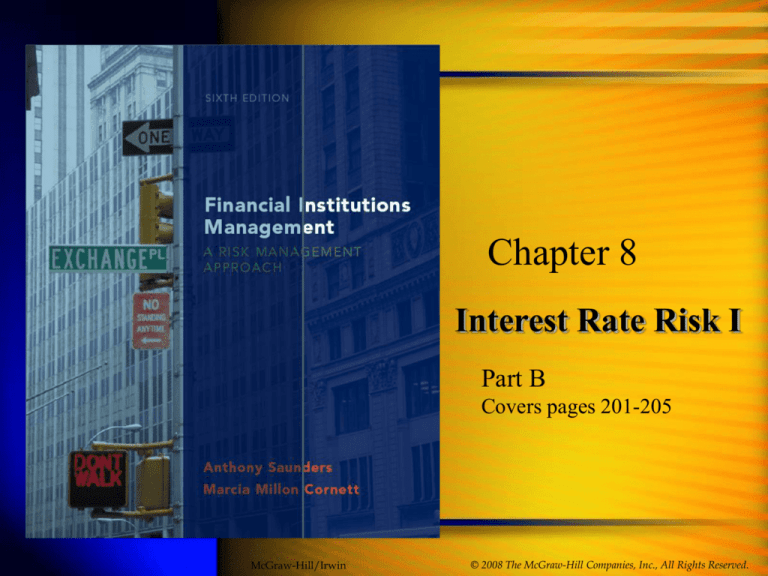
Chapter 8
Interest Rate Risk I
Part B
Covers pages 201-205
McGraw-Hill/Irwin
© 2008 The McGraw-Hill Companies, Inc., All Rights Reserved.
Repricing Gap Example
Assets
1-day
$ 20
>1day-3mos.
30
>3mos.-6mos. 70
>6mos.-12mos. 90
>1yr.-5yrs.
40
>5 years
10
Liabilities
$ 30
40
85
70
30
5
Gap Cum. Gap
$-10
$-10
-10
-20
-15
-35
+20
-15
+10
-5
+5
0
8-2
Applying the Repricing Model
Example II:
If we consider the cumulative 1-year gap,
DNII = (CGAPone year) DR = (-$15 million)(.01)
= -$150,000.
8-3
Equal Rate Changes on RSAs, RSLs
Example: Suppose rates rise 1% for RSAs
and RSLs. Expected annual change in NII,
DNII = CGAP × D R
= -$15 million × .01
= -$150,000
With positive CGAP, rates and NII move in
the same direction.
Change proportional to CGAP
8-4
Unequal Changes in Rates
8-5
If changes in rates on RSAs and RSLs are
not equal, the spread changes. In this case,
DNII = (RSA × D RRSA ) - (RSL × D RRSL )
Repricing Gap Example
Assets
Liabilities Gap Cum. Gap
1-day
$ 20
$ 30
$-10
$-10
>1day-3mos.
30
40
-10
-20
>3mos.-6mos. 70
85
-15
-35
>6mos.-12mos. 90
70
+20
-15
210
225
>1yr.-5yrs.
40
30
+10
-5
>5 years
10
5
+5
0
8-6
Unequal Rate Change Example
8-7
Spread effect example:
RSA rate rises by 1.0% and RSL rate rises by 1.0%
DNII = D interest revenue - D interest expense
= ($210 million × 1.0%) - ($225 million × 1.0%)
= $2,100,000 -$2,250,000 = -$150,000
Unequal Rate Change Example
8-8
Spread effect example:
RSA rate rises by 1.2% and RSL rate rises by 1.0%
DNII = D interest revenue - D interest expense
= ($210 million × 1.2%) - ($225 million × 1.0%)
= $2,520,000 -$2,250,000 = $270,000
Unequal Rate Change Example
8-9
Spread effect example:
RSA rate rises by 1.0% and RSL rate rises by 1.2%
DNII = D interest revenue - D interest expense
= ($210 million × 1.0%) - ($225 million × 1.2%)
= $2,100,000 -$2,700,000 = -$600,000
Repricing Model – 1 Year Cum Gap Analysis
Simple Bank
Securities
Consumer Loans
Consumer Loans
Consumer Loans
Prime-Based Loans
Total Assets
Demand Deposits - Fixed
Demand Deposits - Variable
CDs
CDs
CDs
Equity
Total Liabilities & NW
1 year Cum Gap
Change In Mkt Rates
Change in NII
Chang in NII/ Assets
Maturity
Balance
0.75
0.5
1.5
3
3
9,000
10,000
15,000
16,000
50,000
100,000
5
15,000
35,000
30,000
5,000
5,000
10,000
100,000
0.01
0.5
0.75
2
NA
Repricing
0 to 1
>1
9,000
10,000
15,000
16,000
50,000
69,000
15,000
35,000
30,000
5,000
5,000
70,000
-1,000
1%
-10
-.01%
8-10
Repricing Model – 1 Year Cum Gap Analysis
Simple Bank
Securities
Consumer Loans
Consumer Loans
Consumer Loans
Mortgage Loans
Total Assets
Demand Deposits - Fixed
Demand Deposits - Variable
CDs
CDs
CDs
Equity
Total Liabilities & NW
1 year Cum Gap
Change In Mkt Rates
Change in NII
Chang in NII/ Assets
Maturity
Balance
0.75
0.5
1.5
3
3
9,000
10,000
15,000
16,000
50,000
100,000
5
0.01
0.5
0.75
2
NA
15,000
35,000
30,000
5,000
5,000
10,000
100,000
Repricing
0 to 1
>1
9,000
10,000
15,000
16,000
50,000
19,000
15,000
35,000
30,000
5,000
5,000
70,000
-51,000
1%
-510
-.51%
8-11
Difficult Balance Sheet Items
Equity/Common Stock O/S
Treat as 30% repricing over 5 years/duration = 5 years
70% repricing immediately/duration = 0
Passbook Accounts
Ignore for repricing model, duration/maturity = 0
Demand Deposits
8-12
Treat as 20% repricing over 5 years/duration = 5 years
80% repricing immediately/duration = 0
Amortizing Loans
We will bucket at final maturity, but really should be
spread out in buckets as principal is repaid. Not a
problem for duration/market value methods
Difficult Balance Sheet Items
Prime-based loans
Adjustable rate mortgages
Put in based on adjustment date
Repricing/maturity/duration models cannot cope with
life-time cap
Assets with options
Repricing model cannot cope
Duration model does not account for option
Only market value approaches have the capability to
deal with options
Mortgages are most important class
Callable corporate bonds also
8-13
Prime Rate Vs Fed Funds 1955-2009
Fed Funds Rate
Prime Rate
20
8-14
25
15
10
5
0
08
Ju l06
Ju l04
Ju l02
Ju l00
Ju l98
Ju l96
Ju l94
Ju l92
Ju l90
Ju l88
Ju l86
Ju l84
Ju l82
Ju l80
Ju l78
Ju l76
Ju l74
Ju l72
Ju l70
Ju l68
Ju l66
Ju l64
Ju l62
Ju l60
Ju l58
Ju l56
Ju l54
Ju l-
Prime Rate Vs Fed Funds 1997-2009
7
Fed Funds
6
Prime Rate
8-15
10
9
8
5
4
3
2
1
0
9
n-0
Ju
8
c-0
De
8
n-0
Ju
7
c-0
De
7
n-0
Ju
6
c-0
De
6
n-0
Ju
5
c-0
De
5
n-0
Ju
4
c-0
De
4
n-0
Ju
3
c-0
De
3
n-0
Ju
2
c-0
De
2
n-0
Ju
1
c-0
De
1
n-0
Ju
0
c-0
De
0
n-0
Ju
9
c-9
De
9
n-9
Ju
8
c-9
De
8
n-9
Ju
7
c-9
De
-9 7
n
Ju
Prime Rate Vs Fed Funds 2007-2009
Prime Rate
6
8-16
9
8
7
Fed Funds
5
4
3
2
1
0
9
00
7/2
8/ 2 2 009
7/
7/ 2 2 009
7/
6/ 2 009
7/2
5/ 2 2 009
7/
4/ 2 009
7/2
3/ 2 /2 009
7
2/ 2 009
7/2 0 8
0
1/ 2
2
/
8
/27
12 / 200
8
/27
11 / 200
/27
10 2 008
7/
9/ 2 008
7/2
8/ 2 2 008
7/
7/ 2 008
7/2
6/ 2 2 008
7/
5/ 2 2 008
7/
4/ 2 008
7/2
3/ 2 2 008
7/
2/ 2 2 008
7/
7
1/ 2 / 200
7
/27
12 / 200
7
/27
11 / 200
/27
10 2 007
7/
9/ 2 2 007
7/
8/ 2 007
7/2
7/ 2 2 007
7/
6/ 2
Repricing Model – 1 Year Cum Gap Analysis
Simple Bank
Repricing
Maturity
Balance
0 to 1
Securities
0.75
9,000
9,000
Consumer Loans
0.5
10,000
10,000
Consumer Loans
1.5
15,000
15,000
Consumer Loans
3
16,000
16,000
Prime-Based Loans
3
50,000
50,000
100,000
69,000
Total Assets
Demand Deposits - Fixed
5
15,000
Demand Deposits - Variable
0.01
35,000
35,000
CDs
0.5
30,000
30,000
CDs
CDs
0.75
2
5,000
5,000
5,000
Equity
NA
10,000
Total Liabilities & NW
1 year Cum Gap
100,000
15,000
5,000
70,000
-1,000
Change In Mkt Rates
2%
Change in NII
-20
Chang in NII/ Assets
>1
-.02%
8-17
Repricing Model – 1 Year Cum Gap Analysis
Simple Bank
Repricing
Maturity
Balance
0 to 1
Securities
0.75
9,000
9,000
Consumer Loans
0.5
10,000
10,000
Consumer Loans
1.5
15,000
15,000
Consumer Loans
3
16,000
16,000
Prime-Based Loans
3
50,000
50,000
100,000
69,000
Total Assets
Demand Deposits - Fixed
5
15,000
Demand Deposits - Variable
0.01
35,000
35,000
CDs
0.5
30,000
30,000
CDs
CDs
0.75
2
5,000
5,000
5,000
Equity
NA
10,000
Total Liabilities & NW
1 year Cum Gap
Change In Mkt Rates
Change in NII
Chang in NII/ Assets
100,000
>1
15,000
5,000
70,000
-1,000
6%
-60
-.07%
8-18
Repricing Model – 1 Year Cum Gap Analysis
Simple S&L
Maturity
Balance
Securities
Consumer Loans
Consumer Loans
Consumer Loans
Fixed Rate Mortgages
Total Assets
0.75
0.5
1.5
3
30
12,000
2,000
2,000
2,000
82,000
100,000
Demand Deposits - Fixed
NOW Accounts
CDs
CDs
CDs
Equity
Total Liabilities & NW
5
0.01
0.5
0.75
2
NA
1 year Cum Gap
Change In Mkt Rates
Change in NII
Chang in NII/ Assets
0
20,000
61,000
10,000
5,000
4,000
100,000
Repricing
0 to 1
>1
12,000
2,000
2,000
2,000
82,000
14,000
0
20,000
61,000
10,000
5,000
91,000
-77,000
1%
-770
-.77%
8-19
Repricing Model – 1 Year Cum Gap Analysis
Simple S&L
Maturity
Balance
Securities
Consumer Loans
Consumer Loans
Consumer Loans
Fixed Rate Mortgages
Total Assets
0.75
0.5
1.5
3
30
12,000
2,000
2,000
2,000
82,000
100,000
Demand Deposits - Fixed
NOW Accounts
CDs
CDs
CDs
Equity
Total Liabilities & NW
5
0.01
0.5
0.75
2
NA
1 year Cum Gap
Change In Mkt Rates
Change in NII
Chang in NII/ Assets
0
20,000
61,000
10,000
5,000
4,000
100,000
Repricing
0 to 1
>1
12,000
2,000
2,000
2,000
82,000
14,000
0
20,000
61,000
10,000
5,000
91,000
-77,000
2%
-1,540
-01.54%
8-20
Repricing Model – 1 Year Cum Gap Analysis
Simple S&L
Maturity
Balance
Securities
Consumer Loans
Consumer Loans
Consumer Loans
Fixed Rate Mortgages
Total Assets
0.75
0.5
1.5
3
30
12,000
2,000
2,000
2,000
82,000
100,000
Demand Deposits - Fixed
NOW Accounts
CDs
CDs
CDs
Equity
Total Liabilities & NW
5
0.01
0.5
0.75
2
NA
1 year Cum Gap
Change In Mkt Rates
Change in NII
Chang in NII/ Assets
0
20,000
61,000
10,000
5,000
4,000
100,000
Repricing
0 to 1
>1
12,000
2,000
2,000
2,000
82,000
14,000
0
20,000
61,000
10,000
5,000
91,000
-77,000
6%
-4,620
-4.62%
8-21
Comparison of 1980 Bank vs S&L
No Change in Rates
Simple Bank
Yiel d
Balance
Interest
Assets
6.5 %
100,000
Liabilities
2.5 %
90,000
0
10,000
Equity
8-22
No Change in Rates
Simple S&L
Yield
Balance
Interest
6,500
Assets
7.0%
100,000
7,000
-2,250
Liabilities
4.9%
96,000
-4,704
0
4,000
Equity
NII
4,250
NII
2,296
Operating Expenses
-2,000
Operating Expenses
-1,400
Pre-tax income
2,250
Pre-tax income
896
Taxes at 35%
-788
Taxes at 35%
-314
Net income
1,463
Net income
582
ROA
1.46%
ROA
0.58%
ROE
14.6%
ROE
14.6%
8-23
Comparison of 1980 Bank vs S&L
Rates Up 6%
Rates Up 6%
Simple Bank
Yield
Balance
Interest
Simple S&L
Yield
Balance
Interest
Assets
10.6%
100,000
10,640
Assets
7.8%
100,000
7,840
Liabilities
7.3%
90,000
-6,570
Liabilities
10.6%
96,000
-10,176
0
10,000
0
4,000
Equity
Equity
NII
4,070
NII
-2,336
Operating Expenses
-2,000
Operating Expenses
-1,400
Pre-tax income
2,070
Pre-tax income
-3,736
Taxes at 35%
-725
Taxes at 35%
1,308
Net income
1,346
Net income
-2,428
ROA
1.35%
ROA
-2.43%
ROE
13.5%
ROE
-60.7%
Restructuring Assets & Liabilities
The FI can restructure its assets and
liabilities, on or off the balance sheet, to
benefit from projected interest rate changes.
Positive gap: increase in rates increases NII
Negative gap: decrease in rates increases NII
The “simple bank” we looked at does not
appear to be subject to much interest rate
risk.
Let’s try restructuring for the “Simple S&L”
8-24
Weaknesses of Repricing Model
8-25
Weaknesses:
Ignores market value effects and off-balance
sheet (OBS) cash flows
Overaggregative
Distribution of assets & liabilities within individual
buckets is not considered. Mismatches within
buckets can be substantial.
Ignores effects of runoffs
Bank continuously originates and retires consumer
and mortgage loans and demand deposits/passbook
account balances can vary. Runoffs may be ratesensitive.
A Word About Spreads
Text example: Prime-based loans versus
CD rates
What about libor-based loans versus CD
rates?
What about CMT-based loans versus CD
rates
What about each loan type above versus
wholesale funding costs?
This is why the industry spreads all
items to Treasury or LIBOR
8-26
*The Maturity Model
8-27
Explicitly incorporates market value effects.
For fixed-income assets and liabilities:
Rise (fall) in interest rates leads to fall (rise) in
market price.
The longer the maturity, the greater the effect of
interest rate changes on market price.
Fall in value of longer-term securities increases
at diminishing rate for given increase in interest
rates.
Maturity of Portfolio*
8-28
Maturity of portfolio of assets (liabilities)
equals weighted average of maturities of
individual components of the portfolio.
Principles stated on previous slide apply to
portfolio as well as to individual assets or
liabilities.
Typically, maturity gap, MA - ML > 0 for most
banks and thrifts.
*Effects of Interest Rate Changes
Size of the gap determines the size of
interest rate change that would drive net
worth to zero.
Immunization and effect of setting
MA - ML = 0.
8-29
8-30
*Maturities and Interest Rate Exposure
If MA - ML = 0, is the FI immunized?
Extreme example: Suppose liabilities consist of
1-year zero coupon bond with face value $100.
Assets consist of 1-year loan, which pays back
$99.99 shortly after origination, and 1¢ at the
end of the year. Both have maturities of 1 year.
Not immunized, although maturity gap equals
zero.
Reason: Differences in duration**
**(See Chapter 9)
*Maturity Model
8-31
Leverage also affects ability to eliminate
interest rate risk using maturity model
Example:
Assets: $100 million in one-year 10-percent
bonds, funded with $90 million in one-year 10percent deposits (and equity)
Maturity gap is zero but exposure to interest rate
risk is not zero.
Modified Maturity Model
Correct for leverage
to immunize, change:
MA - ML = 0 to
MA – ML& E = 0 with ME = 0
(not in text)
8-32



